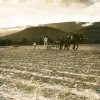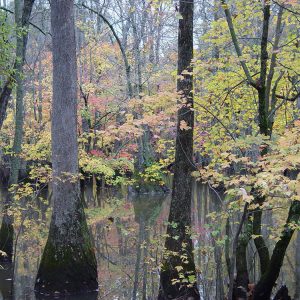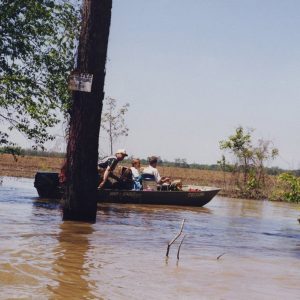calsfoundation@cals.org
Cache River National Wildlife Refuge
The 62,000-acre Cache River National Wildlife Refuge is the most important wintering area for ducks and the largest remaining tract of contiguous bottomland hardwood forest in North America. It runs along the floodplain of the Cache River and Bayou DeView for seventy air miles from the mouth of the Cache River at Clarendon (Monroe County) to Grubbs (Jackson County), encompassing Jackson, Monroe, Prairie, and Woodruff counties. In February 2004, the ivory-billed woodpecker, once thought extinct, was reported to be rediscovered on the refuge.
The refuge was established in 1986 as one of 540 national wildlife refuges administered by the U.S. Fish and Wildlife Service. The refuge’s primary objective is to provide habitat for migratory waterfowl and other birds, to protect and restore the bottomland hardwood resources of the basin, to protect endangered species, and to provide recreation and environmental education.
In the 1970s, the U.S. Army Corps of Engineers proposed to dredge and straighten several miles of the Cache River to reduce flooding. But Rex Hancock, a dentist from Stuttgart (Arkansas County) and an avid duck hunter, formed a group of citizens who opposed the channelization, fearing it would destroy the river’s natural environment. Hancock also recruited many organizations, and he and his coalition sued to stop the channelization. The litigation held off the project until a federal refuge was established in the late 1970s. The Cache River National Wildlife Refuge is a part of the area saved by the dedication of Hancock, the “Cache River champion.”
As one of the few remaining areas in the lower Mississippi River Valley not drastically altered by channelization and drainage, the refuge contains one of the most intact bottomland hardwood forests in the Mississippi Valley region. The wetlands were recognized in 1990 by the sixty-one nations of the United Nations Ramsar Convention, an international treaty for wetlands preservation, as “Wetlands of International Importance,” along with the Florida Everglades, Chesapeake Bay, and Georgia’s Okefenokee Swamp. With the discovery of the ivory-billed woodpecker, the refuge also is recognized as an “Important Bird Area” by the National Audubon Society.
The refuge’s boundary changes frequently because the refuge is in the land acquisition phase. The refuge’s approved acquisition boundary contains 175,000 acres. Acquisition is on a willing-seller basis and has allowed many isolated tracts to be connected. The long-term goal is to reforest the refuge to provide a hardwood corridor the length of the acquisition boundary. Several areas have been set aside as water management areas to provide for several habitat types, including green timber reservoirs for waterfowl, moist-soil management units, mud flats for migratory shorebirds, and cooperative farming to provide food for waterfowl.
The refuge is popular for hunting, fishing, wildlife observation, and photography. It is home to more than fifty species of mammals, 247 species of birds, and forty-eight species of reptiles and amphibians. Hunting seasons include small game (September to February); muzzleloader deer hunting (October); archery deer hunting (October to February); modern-gun deer hunting (November); and duck and goose hunting (November to January). Fishing is allowed year round. Managed-access areas have been established for those hoping to catch sight of the ivory-billed woodpecker.
The refuge office is at Dixie (Prairie County) sixteen miles south of Augusta (Woodruff County). Approximately 120,000 people visit the refuge annually.
For additional information:
Bowman, Steve, and Steve Wright. Arkansas Duck Hunters Almanac. Fayetteville, AR: Ozark Delta Press Inc., 1998.
“Cache River National Wildlife Refuge.” U.S. Fish & Wildlife Service. http://www.fws.gov/cacheriver/ (accessed August 10, 2023).
Wright, Steve. “Where the River Flows through the Forest.” National Wildlife Federation. https://www.nwf.org/Magazines/National-Wildlife/2000/Where-River-Flows-Through-Forest (accessed August 10, 2023).
Paula Harmon Barnett
Woodruff County, Arkansas




 Bayou DeView
Bayou DeView  Bayou DeView
Bayou DeView  Cache River National Wildlife Refuge
Cache River National Wildlife Refuge 



Comments
No comments on this entry yet.